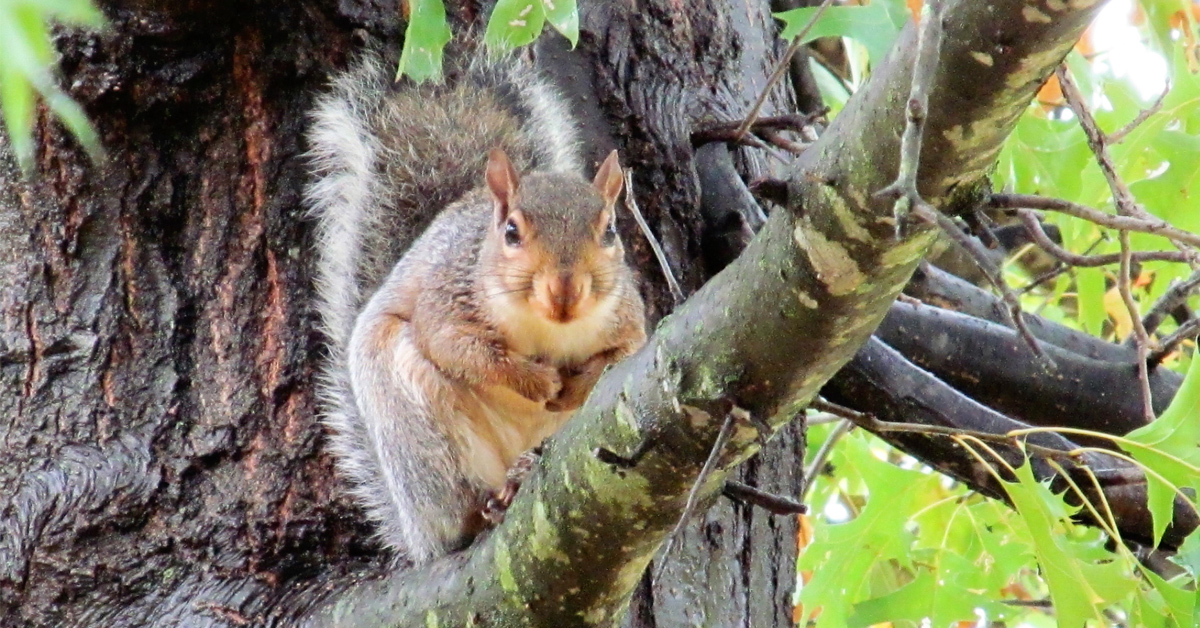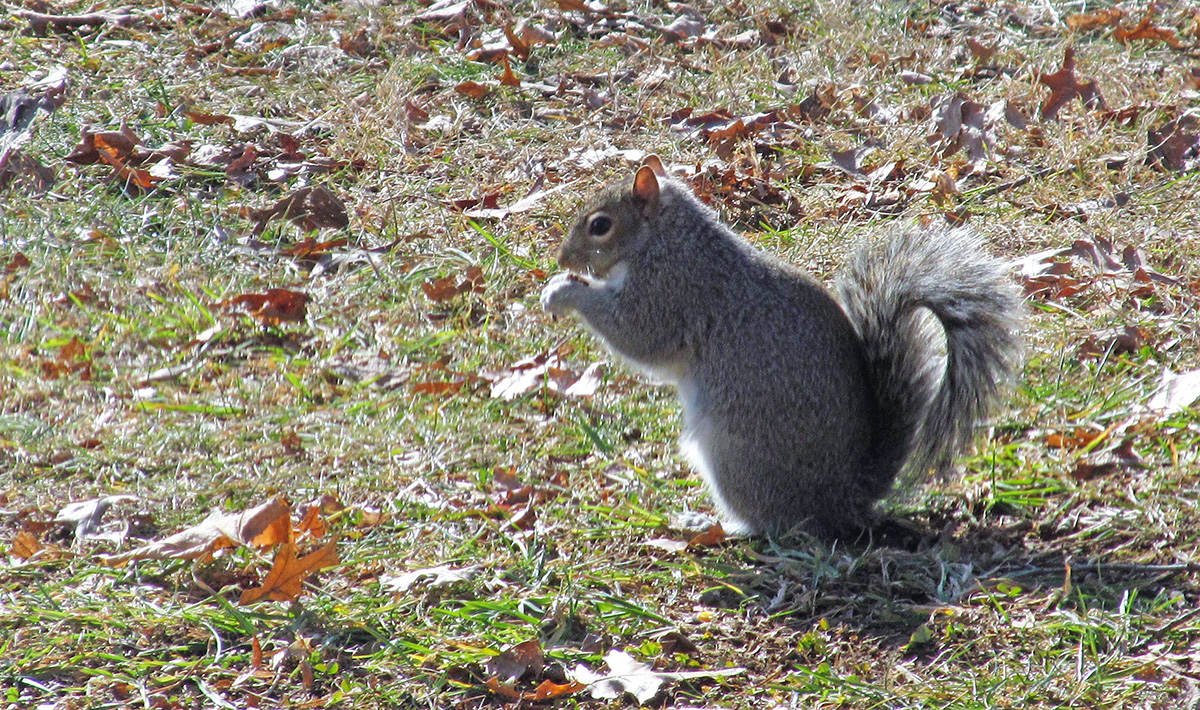
By Gerald Almy
Photos by Gerald Almy
Yes, their popularity has slipped a bit in recent years with the rise in deer and turkey numbers, but many Virginia sportsmen still pursue gray and fox squirrels enthusiastically in late fall and winter. It’s easy to see why.
For starters, bushytails offer excellent chances for success. It’s not uncommon to walk out of the woods with a hefty bulge in the game pouch, often a full limit of six squirrels—gray and fox combined.
The furry quarry can also be pursued with a variety of tactics to suit your hunting preference. Try stand-hunting in an oak flat littered with acorn shells, still-hunting along the edge of a creek, floating serenely down rivers (with your life jacket on!), or hunting with rambunctious dogs.
Squirrels are abundant throughout Virginia wherever there is forested habitat. Some of the best hunting occurs where small blocks of woods are intermixed with meadows, crops, and brushy field corners.
The final attraction of squirrel hunting is the delicious meals they provide when barbequed, pan-fried, or made into a traditional Brunswick Stew. Many early settlers in our country relied almost totally on squirrels and other game to keep the larder full.
Here are some of the most important tips I’ve learned from years of hunting this intriguing small game quarry—a species that still draws dedicated Virginia sportsmen and women today, centuries after Daniel Boone and other early settlers first pursued them.
- Be alert. Don’t expect to necessarily see a whole squirrel as you search for game. Look for an odd hump in a branch, a twitching tail dangling off a limb, leaves shaking in a treetop, or movement on the forest floor.
- Find the mast. Squirrels will be most abundant where the food is plentiful. Look for mast such as acorns, hickories, and walnuts. Then concentrate on areas that have the heaviest concentrations of these nuts in your hunting territory. Walnuts draw squirrels early. Hickories and acorns can provide great mid and late-season sport.
- Don’t neglect other foods. Squirrels also feed on other forage like fruits and berries as well as crops such as corn. Search along the edges of cornfields where they border mature forests. Those areas offer the double attraction of corn and acorns—a squirrel buffet! Fox squirrels are particularly fond of corn.
- Listen for squirrel talk. While you’ll often detect your quarry with your eyes, use your ears as well. Squirrels make lots of telltale calls that give away their location to the savvy hunter, just like a turkey gobbling or an elk bugling. Listen for their sounds such as cat-like meowing, muffled barking and the most easily detected call—angry scolding when they sense danger or an intruder.
- Be alert for other giveaway sounds. Besides their vocalizations, squirrels make lots of other noises as they go about their daily lives that can alert you to their location. Listen for the sound of shaking leaves and rattling branches in trees as they jump from one limb to another or the rustling of leaf-litter as they scamper through the woods searching for acorns. You might also hear the sound of sharp teeth crunching on a nut or the gentle pitter-patter of shell fragments falling to the forest floor.

Keep an ear out for squirrels rustling through leaves or gnawing on acorns.
- Try squirrel calls. Hunters love to call game, from rattling in bucks to luring in spring turkeys with yelps, clucks, and purrs. Try some of the squirrel calls on the market and you’ll find they help you locate your quarry and also bring it out in the open for a shot. Tap, shake, or squeeze them to produce alarm barks or mating squeals. Both sounds can incite vocal responses or movement from squirrels, giving you the opportunity for a shot. If you forget your call, try this trick: tap two hickory nuts together or shake a few small rocks in your hands.
- Focus where you look. During the fall, early in the morning look for squirrels in low branches of trees and also on the ground gathering nuts and searching for grain, berries, and fruits. From mid-morning to mid-afternoon, focus on higher branches in trees for bushytails gnawing on nuts or heading back to their dens for a midday nap. Late in the afternoon, focus on lower limbs again as well as on the ground. Snow on the ground can reveal squirrel tracks and help you pinpoint where they are most abundant.
- Hunt when the quarry is most active. In early season, morning and evening hours see the most squirrel activity. In winter, squirrels wait for things to warm up and the midday hours are often best.
- Be patient. If you are stand-hunting in a prime area and harvest a squirrel, note the location where it fell, but don’t jump up to retrieve it. Simply mark it carefully in your mind with a tree, stump, or other landmark and wait. In a few minutes, other squirrels in the area will calm down and start moving again. A few barks on a call will help lure them back out. After you’ve downed two or three squirrels and activity cools off, go claim your prizes and move to a different area.
- Use the right gear. Choose a 12-28 gauge shotgun with an improved or modified choke loaded with size 4-6 shot or a rimfire rifle where legal. Camouflage or at least dull-colored clothing helps you avoid being detected. Also wear a vest or coat with a game pouch to hold both squirrels and a hearty lunch. To keep your feet warm, be sure to don a sturdy pair of insulated, waterproof boots. Wearing some blaze orange for the hike into or out of your hunting area is a good safety step.
- Pace yourself. Move slowly when still-hunting squirrels. Walk at a speed about like you would use when sneaking along trying to catch a deer undetected. Pause often and do most of your scanning for game and listening while you’re standing still. A light pair of binoculars can help you differentiate a knot on a tree from a hunkered-down bushytail. Once you’ve searched an area thoroughly with your eyes and listened intently, move forward 50-100 yards, depending on how abundant squirrels are. Then pause again to listen and scour the new area with your eyes and optics.
There are many other tips we could cover, but these eleven should help increase your success rate and enjoyment when hunting Virginia’s overlooked gray and fox squirrel populations.


